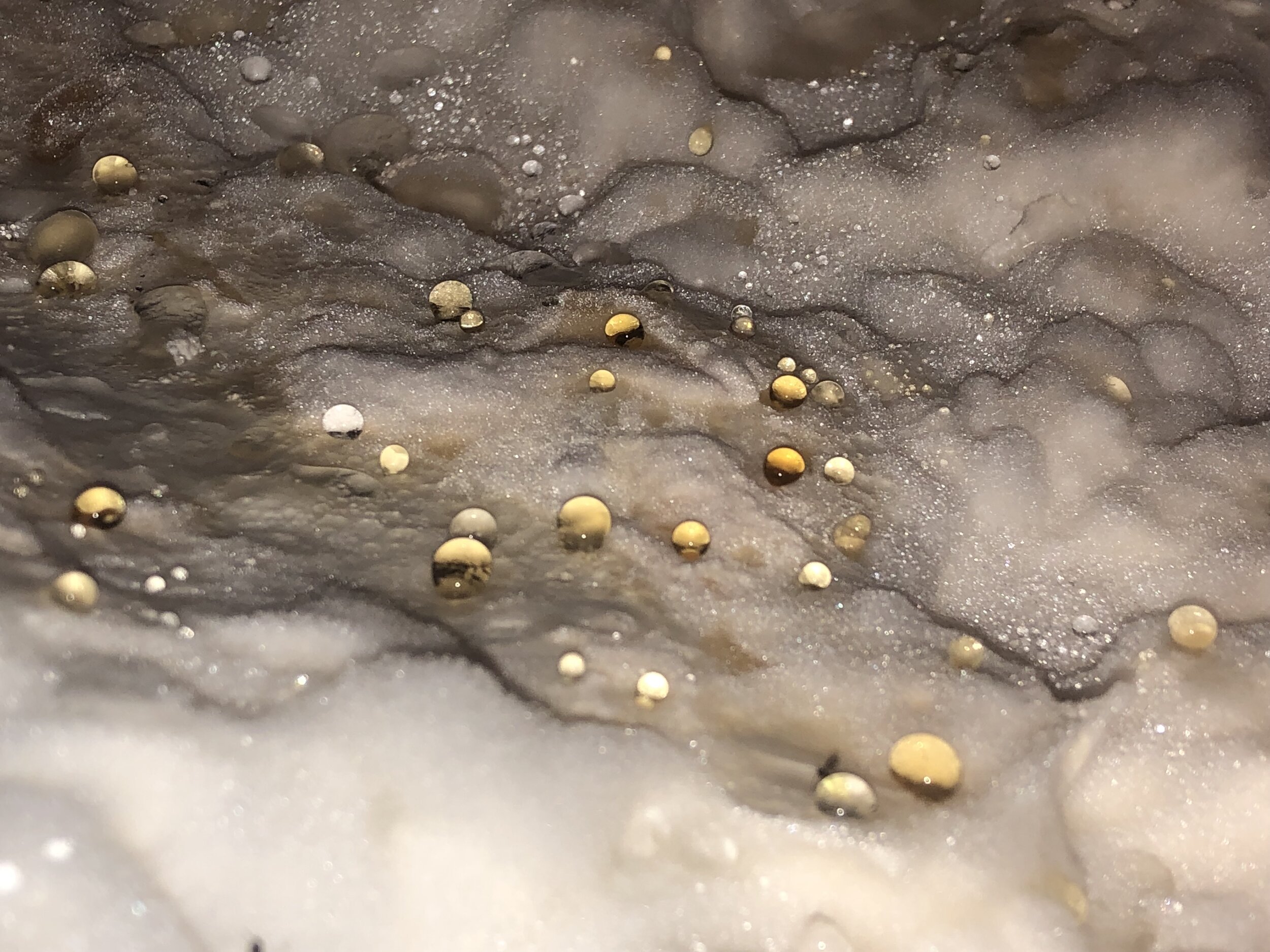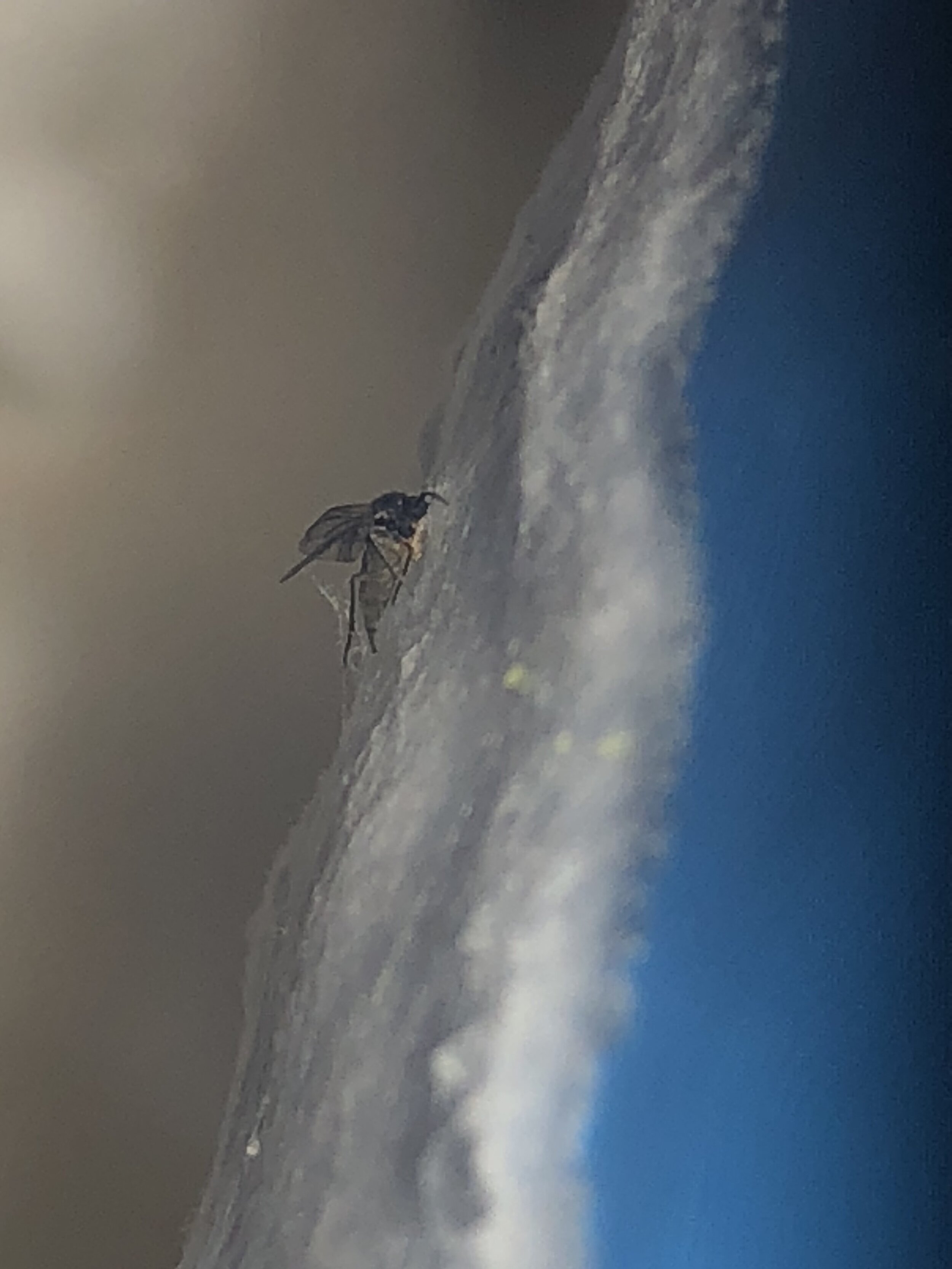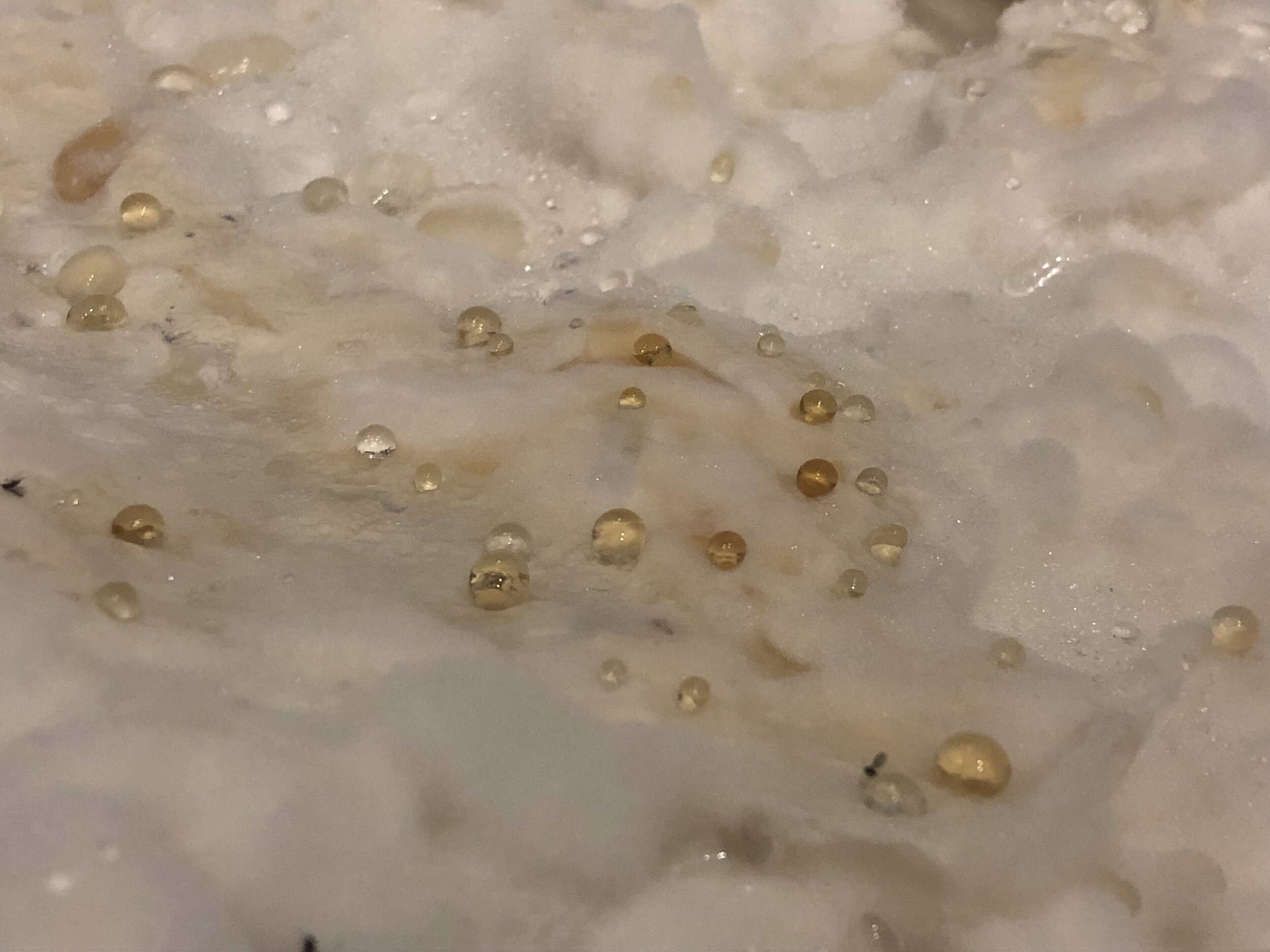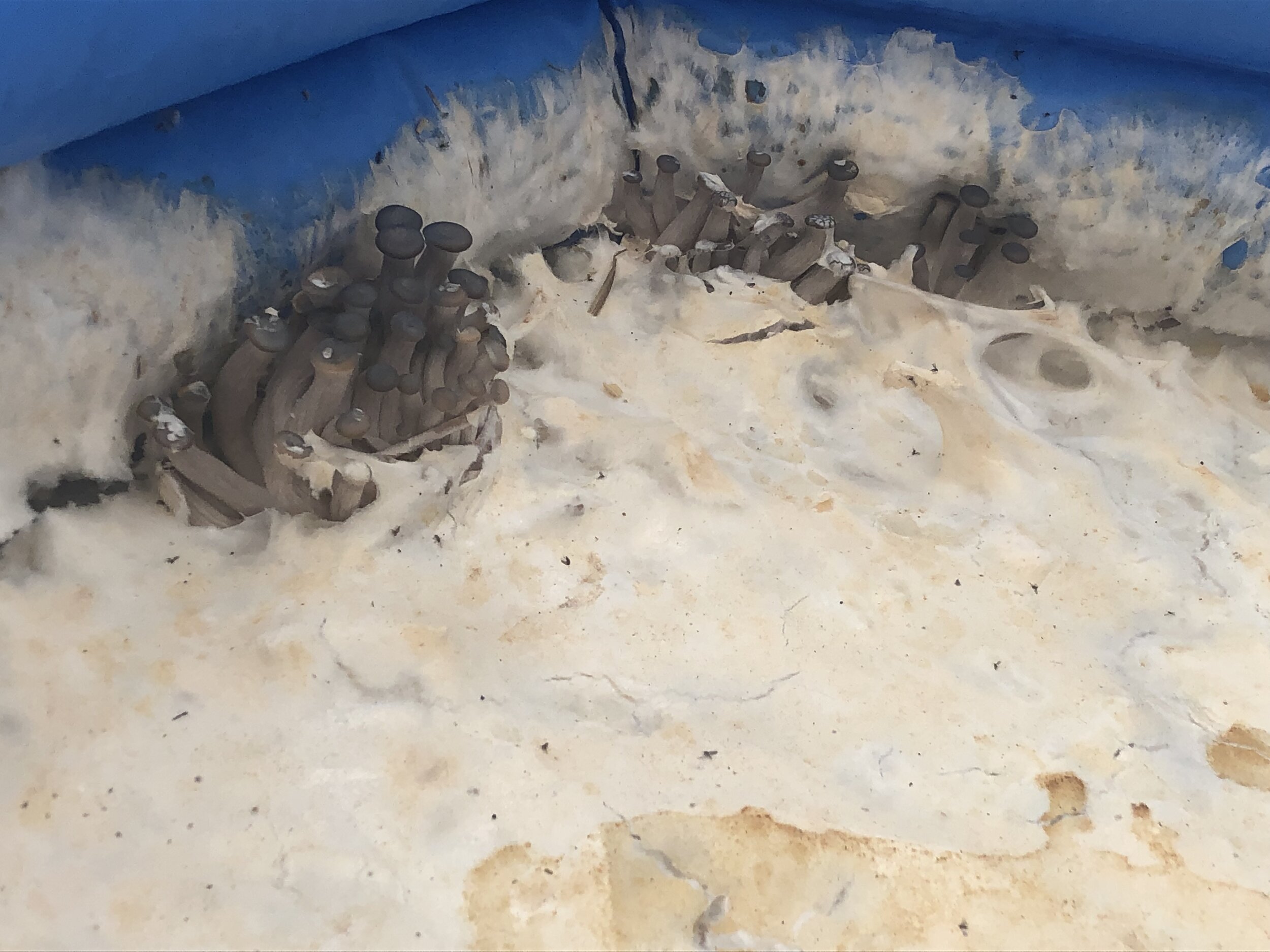Decomposing UTOPIA
Decomposing UTOPIA explores the digestion of history, through the absorption, decomposition, and rebirth, of human biochemical sociocultural artifacts, by a fungal symbiont. Through the absorption of atmospheric pollution, the intake of cellular fragments, skin flakes, human-associated microorganisms, sonic stimulation, the mycelial mass engulfs the human body, disassembling nature and culture through radical cohabitation. In this process, the artist relinquishes control of the being being birthed, and becomes engaged in symbiotic co-modulation, in which response-ability, opposed to domination of living matter, composes the piece as the maintenance of a relational ecology. Forged through interwoven perceptions and signal molecules, such as hormones, spores, skin cells, and fungal-associated bacteria, this emergent ecology hopes to position the artist as an actor enacting the role of cell-grower.
Through the parallel formation of semiotic bridges between human and mycelium, Decomposing UTOPIA investigates the potential of multi-species world-weaving as an ontological methodology for the naturalcultural metabolism of events of radical ecological transformation.
Decomposing UTOPIA engages with the history of New York City through a set of ritual placement, and absorption ceremonies conducted across Lower Manhattan. The first ceremony takes place at Collect Pond Park, the site of an ancient lake now long covered in layers of compacted and entangled industrial, and post-industrial worldings. In the 1800s, Collect pond, a deep lake fed by a natural spring, was drained due to high levels of pollution, and filled with rubbish from a growing Manhattan. The new land built of the waste of capitalism, was named Paradise Square. Due to poor planning, Paradise Square began to sink into the rotting garbage held beneath it releasing noxious fumes (1). This area then became America’s first slum (2). The complex history of this region, and material being, as as the spirit, of the waters held beneath the impervious mantle of government buildings, and city parks, require absorption and release back to the ocean so that they can be properly digested. Only through processing the past, through truly processing ecocide, and human suffering, can we produce visions of a future defined by respect and flourishing.
Mannahatta before and after New York city: Image courtesy of Eric W. Sanderson
The Manhattan Detention Complex, formerly known as “The Tombs” also sits atop the sealed spring that fed Collect Pond. A prison was initially built on the rubbish used to fill the pond, and began sinking into the muck. This building was later replaced by the building that stands now by driving steel pylons into the bedrock (5). The thoughtless runaway urbanization of Lower Manhattan has rendered this ecosystem as a collection of ghostly memories (6). The voice of the spring sealed beneath these structures on the part of architects, engineers, policy makers, developers, has not been silenced, however, and it continues to flood basements in Chinatown to this day, evoking the possibility of renewal.
The absorption ceremony will begin at higher elevation in Chinatown, and descends into Collect Pond Park.
HolobiontEye-We-i-AM
This ceremony will call out to the ghost of Collect Pond, asking for is diamagnetic psycho-chaotic energy in order to make the mycelium aware of the metamorphic death of an ecosystem. The ecological history will be absorbed into the mycelium disk, which will be asked for its help in producing offspring capable of aiding in the creation symbiotic futures. The forgiveness of the ghost of collect pond will be asked and guidance will also be asked of the mycelial digester. Guidance will be imbued into the fruiting bodies which, after being allowed to release their progeny into the air, will be eaten by the human symbiont.
The mycelial structure will then be released into the sea, imparting the ghost of the Spring to The Sea.
After the second flush of fruiting bodies, spores will be harvested and plated on potato dextrose agar. These daughter cultures, the children of Decomposing UTOPIA, will have been born through direct interplay with the post-natural landscape above collect pond, and have been absorbed the ceremonial intention imbued into their parent’s planting in the earth, unifying both sociocultural and ecological digestion in the production of new life.
The daughter cultures will be used to make new mycelial art pieces that will be grounded at other sites requiring socioecological metabolic processing, continuing the lineage and semiotic linkage with the human symbiont across fungal generations. At the successful birth of each generation, the bond between human and fungi grows stronger, leading to increased sensitivity to the other.
One set of the many children of Decomposing UTOPIA will be used to make living islands that support plant life, cleaning the waters in which they float of toxic industrial effluent through combined myco and phytoremediation.
Sky-Bliss
Growth
Decomposing UTOPIA consists of living Pleurotus ostreatus mycelium cultivated on straw, that slowly consumes an internal frame made of bamboo and gourds. The growth of the island took just under 1 month, from spawn acquired from Smallhold in Brooklyn. The straw was pasteurized in my bath water, building a semiotic bridge between the fungi and myself by introducing to human biomolecules and DNA fragments (Figure 1). Pasteurization was achieved by adding three handfuls of Ca(OH)₂ to increase the pH to above 10, and allowing the straw to soak for 18 hours.
Figure 1: My pasteurization chamber full of soaked straw. Here, the water has been allowed to drain for 2 hours. The bamboo and gourd frame is also shown.
After draining, the soaked straw was then placed into a 4' foot in diameter kiddy pool. Spawn was broken up with my spatula, and added in layers to ensure quick growth in every direction. The frame was placed in the center of the brick, in order to ensure higher strength for the being’s eventual removal (Figure 2). The frame was then covered by a final layer of straw and covered by a plastic sheet to maintain the humidity necessary for fungal growth (Figure 3). Figure 4 depicts the mycelium completely consuming the growth medium underneath the plastic sheet after 2 and a half weeks (Figure 4).
Figure 2: Frame on top of spawn and soaked straw.
Figure 3: Completely inoculated mycelium island before covering.
Figure 4: Full colonization underneath plastic sheet after 2-3 weeks.
Figure 5: After removing the plastic, the outer layer of mycelium is fluffy and reaching towards higher concentrations of oxygen.
Partial Dehydration/Skin formation
After the mycelium had fully consumed the straw (it is probably still consuming the denser frame), I removed the plastic sheet and allowed the mycelium to dry in the air beneath an open window, exposing it to the atmosphere of E Houston Street and 2nd Avenue. Upon removing the plastic film, I discovered an iridescent world of white fluffy hyphae, and glittering orange droplets of extracellular metabolites (Figure 5, Figure 6). At this stage, I learned that fungus gnats had found their way under the plastic and were flying above the hyphal landscape, consuming mycelial threads, and, as I found, being consumed by the mycelium (Figure 7).
Figure 6: Droplets of cellular metabolites containing antibiotics used to curb infections most likely introduced by fungus gnats.
Figure 7: Fungus gnat being consumed by Pleurotus ostreatus mycelium.
micromacro cosmos
Observing the mycelial landscape before me, I was reminded of an arctic landscape, with iridescent ice formations and strange winged beings feeding on the living ice.
Dehydrated skin
After two weeks of exposure to the atmosphere and in response to the drastic reduction in humidity, the mycelial mass formed a smooth paper like skin (Figure 8). This skin was fragile and multilayered, creating a dynamic topology, and an environment for numerous microorganisms (figure 9).
Figure 8: Paper like skin formed through drying.
Figure 9: Mycelial skin under 40x magnification.
Fruit
The mycelium began to fruit after drying, forming primordia beneath its paper-like skin, which burst forth in eager anticipation of reproduction blooms.
Figure XXXX: The ecology of my apartment after 1 week from first fruit formation.
Figure XXXXXX: 2 day old blue oyster mushrooms protruding from the mycelial skin.
Decomposing PARADISE sitting in Foley Square.
References
1) https://www.tenement.org/blog/what-lies-beneath-a-history-of-collect-pond/
3) Companion Species Manifesto by Donna Haraway
4) Bruno Latour: Actor-Network Theory
5) https://www.nycurbanism.com/brutalnyc/the-tombs
6) The Arts Of Living on a Damaged Planets: Ghosts by Anna Tsing et al.


















